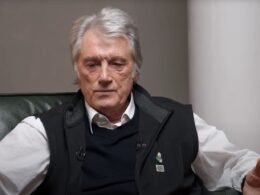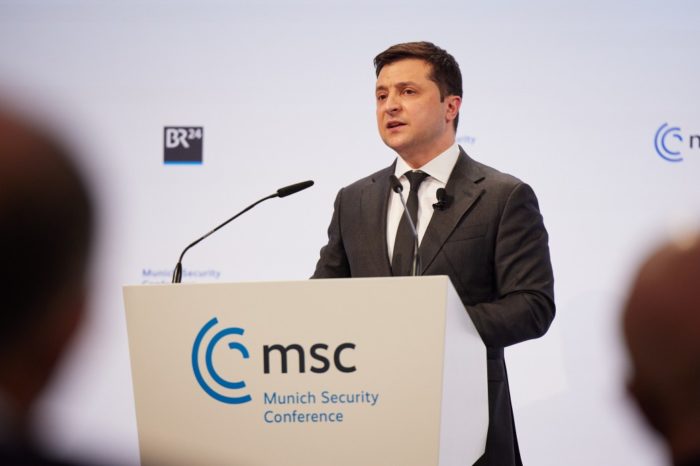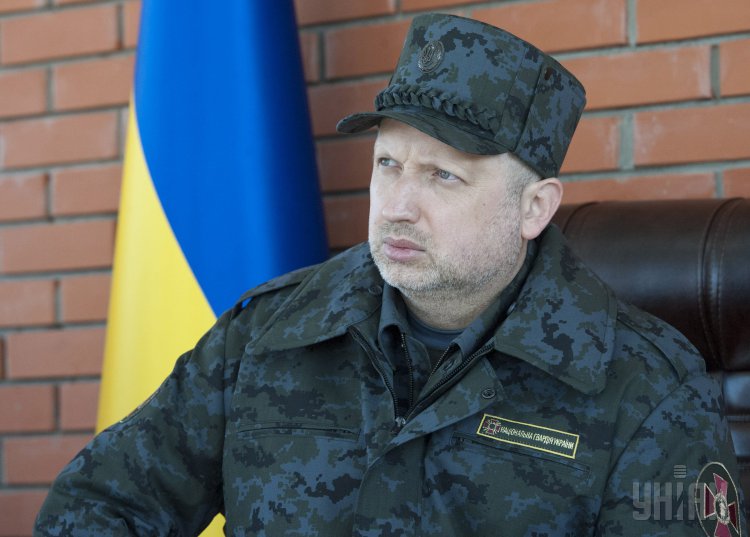When the US was conducting final negotiations with Russia regarding nuclear disarmament of Ukraine in 1994, Russia was already beginning its war against Chechnya and preparing annexation of Crimea — the latter stopped only by the timely deployment of Ukrainian forces. The US regarded Russian "interests in its near abroad" as "legitimate" and, as US Deputy Secretary of State Nelson Strobridge Talbott admitted, "shut down" Ukrainian President Leonid Kravchuk's pleas for genuine security guarantees in exchange for nuclear disarmament.
"The West has failed to adequately respond to the resurgence of Russian hegemony."
"Why did America not help us in 1933?"
"Ukraine must rely only on its own forces for its defenses."
These were the arguments spoken in the Ukrainian Parliament in 1994 before ratification of the Treaty on the Non-proliferation of Nuclear Weapons on 16 November 1994. Citizens were consulted on the issue by the Advisory Council of the Ukrainian Parliament.
The Ukrainian Parliament adopted the Treaty under threats from the US, including threats of international isolation, as well as Russian threats to cut oil and gas supply to Ukraine. The Treaty was adopted contrary to Ukrainian public opinion in 1993, when, according to the independent research center "Democratic Initiatives," 45.3% preferred "nuclear-weapon status" for Ukraine, whereas 35% selected disarmament.

Moreover, contrary to the widespread argument that allegedly nuclear weapons were useless for Ukraine due to Russian control codes, according to Western analysts, Ukraine actually had the technological capacity to break the Russian authorization codes and establish complete operational control over its nuclear arsenal within 12 to 18 months.
These and many other details regarding the nuclear disarmament of Ukraine were revealed in the recent research by George Bogden, a Krauthammer Fellow and an Olin Fellow at Columbia Law School. The research includes never-before-released archival files revealing Washington's error in cudgeling Ukraine to give up its nuclear weapons despite the risk of a Russian invasion.
"These records cut sharply against the rationale for this historical resignation: that Ukraine was incapable of the technical means of operating nuclear weapons and that such weapons wouldn't do much for its security even if it could... On the contrary, the evidence reveals President Bill Clinton's future CIA director concluding that Ukraine did have the means to operate an arsenal... They also show top American officials fretting over Russia's belligerent, irredentist behavior during the negotiations, including repeated concerns about a potential future Russian invasion of Ukraine even as they chided 'whiners' in Kyiv for expressing the same anxieties," Bogden summarizes in his research.
So-called Ukraine-Russia-US negotiations "painfully twisted the arms" of Ukrainian President Kravchuk
In the early 1990s, Ukraine insisted numerous times on the threat from Russia during negotiations with the US, but the Clinton administration decided to "recognize Russian interests" in Ukraine.
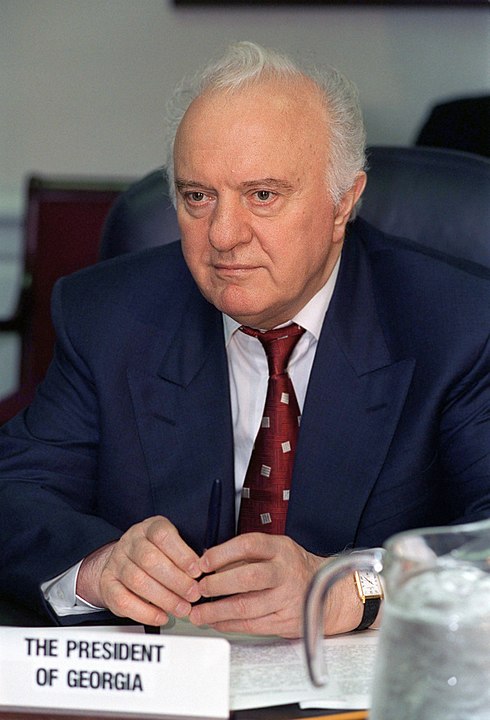
In particular, the unearthed papers show the USSR's last foreign minister, Eduard Shevardnadze, saying during the talks with then-President of Ukraine Leonid Kravchuk that "just one nuclear missile" in Ukrainian hands would have been enough to safeguard its independence from Russia.
In April 1993, Kravchuk confided to then-Georgian president Eduard Shevardnadze his "main headache" that "Moscow and the US together have been twisting my arms painfully" in "demanding [the] transfer [of Ukraine's nuclear weapons] to the Russian Federation."
"I would understand Russia's nastiness," Kravchuk said, "But Americans are even worse—they do not listen to our arguments."
Shevardnadze stressed that the so-called Russian democrats led by Yeltsin, in fact, didn't drop imperial ambitions, and that is why Americans are deeply mistaken in trying to make a deal with them at the expense of Ukrainian and other post-Soviet republics' interests:
"[The Americans] do not know about our terrible, rough relations with the Russian empire [and] the USSR. Without that knowledge, building predictable and trustworthy relations with 'democratic Yeltsin and Russia' would be very difficult, whom [the Americans] currently call 'Russian democrats'...I know many of them, talked to them a lot. They are still sick with imperial infection."
He went on, referring to his previous job — as Soviet foreign minister:
"Being a member of the Politburo I had access to many confidential and top-secret documents—secret reports, notes, different non-papers elaborated in different Soviet structures—the Central Committee offices, KGB, Military Intelligence, think tanks and so forth…I can say that the documents I have read were just horrible and frightening: about the different scenarios of relations of the Center [Moscow] with the Soviet republics... They included the partition of those republics, expelling their populations to different parts of Siberia and the Soviet Far East—indeed some remote places. To accomplish those goals, they will use military force. All those plans are not archival ones! They are fully intact to be used if Moscow makes that decision."

Shevardnadze implored Kravchuk in 1993 to "negotiate so as not to undermine your independence and your security," saying that "if Ukraine succeeds in keeping at least one nuclear missile as a deterrent," it will safeguard its independence "from those madmen in the Kremlin."
This prophetic recommendation from a man who understood the inner workings of the Kremlin never materialized. Historical records also illuminate how American officials blocked any attempts by Kyiv to trade its nuclear arsenal for genuine security guarantees — even going so far as to lobby Europeans to keep Ukraine out of non-NATO security arrangements, Bogden writes in his research.
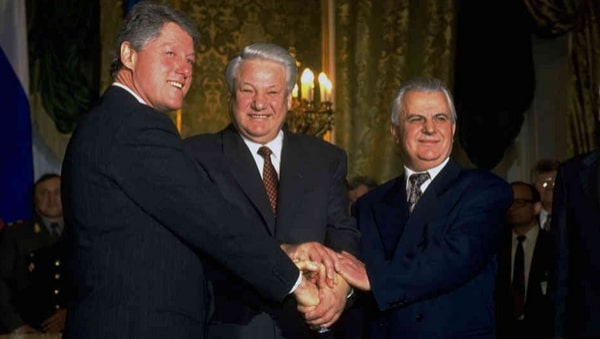
Instead, records now reveal, the US leadership, including President Bill Clinton, maintained respect for Russia's "vital interests in its near abroad." In 1994, on the way to Russia, Clinton's delegation stopped in Kyiv, where then-US Deputy Secretary of State Talbott admitted his superiors "shut down" eleventh-hour pleas regarding security guarantees for Ukraine by "roughing [Ukrainian President Kravchuk] up."
A few days later, Talbott began to accept Russian influence in Central and Eastern Europe. In March 1994, he admitted respect for "Russia's vital interests in the 'near abroad.'"
"It has such interests; we recognize that," he said about Russia. "In fact, we're prepared to help in a variety of ways," including by "the Trilateral Accord with Ukraine" on nuclear disarmament.
The US clearly chose the Russian side, admitting during inner discussions about "formal security guarantees" for Ukraine that "we did not think it appropriate to provide" them, as US Secretary of State in 1992 James Baker put it.
The result was the Budapest Memorandum, which essentially provided Ukraine "security assurances" following the UN charter. When Russia invaded, they proved to be empty words.
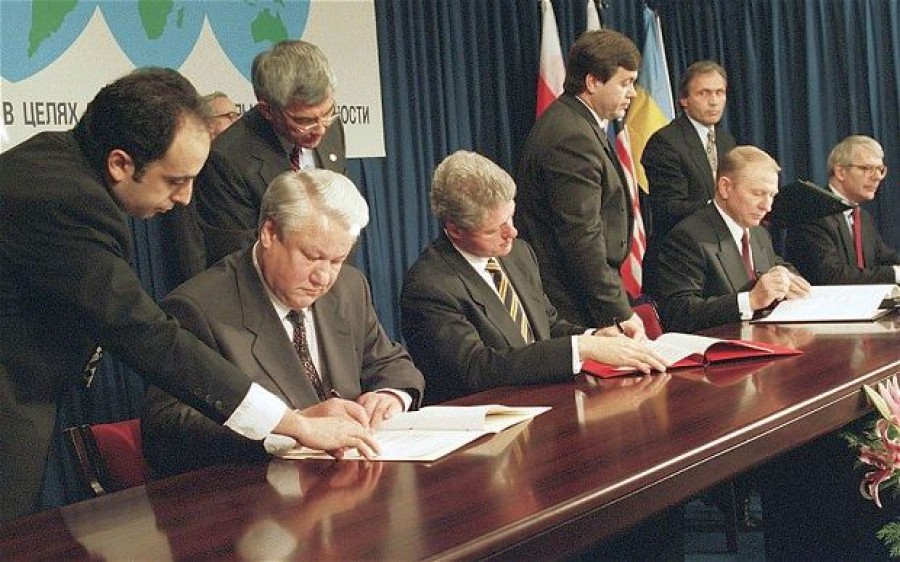
Russia never hid its imperial ambitions during the 1990s, and the US was aware of it
The history of nuclear disarmament of Ukraine under US pressure becomes even more striking, given that the US knew about Russian intentions to subjugate Ukraine under its control and even considered the Russian invasion of Ukraine possible. Following the final trip to Moscow ahead of the Budapest memorandum, Talbott asked
then Secretary of State Warren Christopher rhetorically:
"Do we have good answers to questions about what we'll do if reality refuses to follow the script we're writing for it? What if Russia invades Ukraine?"
The question was never considered seriously enough in a theoretical hope that in the future when needed, such a possibility of invasion could be negotiated away with Moscow. Generally, the new imperial ambitions of Moscow were ignored by the US leaders, blinded by the strongly desired illusion of the seemingly democratic new Yeltsin's Russia.
The US and UK signed the Budapest memorandum on 5 December 1994, when the first battles of the Russian war against the newborn Chechen republic in the Caucasus were already going on. The West largely ignored this war.
Unpunished evil grows: Ukraine war rooted in Russia’s impunity for Chechen genocide
On 11 December 1994, just a week after signing the Budapest memorandum and five days after Chechen leader Dzhokhar Dudaev and Russian Minister of Defense Pavel Granchev had agreed to "avoid the further use of force," Russian forces entered the republic. They launched a massive attack on the Chechen capital of Grozny, leveling it to the ground.
Given all these events, it becomes unsurprising at all that almost immediately after signing the Budapest Memorandum, then-President of Ukraine Leonid Kuchma commented:
"If tomorrow Russia goes into Crimea, no one will raise an eyebrow. Besides… promises, no one ever planned to give Ukraine any guarantees."
It is no accident that Kuchma mentioned the possible invasion of Crimea in 1994, not Donbas or any other region of Ukraine. Already in the spring of 1994, Russia seriously attempted to invade Crimea for the first time, just seven months before signing the Budapest Memorandum. A lasting operation of Russian security forces preceded the attempt. Russia supported local politician Yuriy Meshkov, who was expected to declare the separation of Crimea from Ukraine with the support of local militia. Kremlin also attempted to take under full control the former Soviet Black Sea fleet, which at that time was de-facto split between Ukraine and Russia by half depending on particular soldiers' loyalty.
Only the timely operation of Ukraine's Security Service and the deployment of additional Ukrainian troops to Crimea in 1994 stabilized the situation and prevented Russia from implementing its scenario. However, it returned to the same scenario only with minor amendments in 2014, when Ukraine lacked decisive leadership immediately after the Revolution of Dignity.
The 1994 secret operation that saved Crimea, and perhaps Ukraine, from Russian occupation
Despite widespread arguments about the "uselessness" of those nuclear weapons, Ukraine had the means to operate its nuclear arsenal
Ukraine inherited from the USSR 176 intercontinental ballistic missiles (ICBM) armed with 1,240 nuclear warheads, 44 long-range strategic bombers armed with 588 air-launched cruise missiles (ALCM), and some 2,600 tactical nuclear weapons, including artillery shells, mines, and gravity bombs.
In total, this nuclear arsenal was the third-largest in the world, preceded by the US and Russia.
ICBMs were indeed mostly useless against Russia, given their long-range striking distance and the proximity of Ukraine to Russia. Most of the tactical warheads were also transferred from Ukraine to Russia already in 1992, under the supervision of the US, with little Ukrainian control over the process. What remained were nuclear cruise missiles, and those had the strongest deterrence power against Russia.
Senior US administration officials also appeared confident that Ukraine did, in fact, possess the means to become a fully nuclear-capable state, Bogned concluded in his research. Clinton's CIA Director-in-waiting, James Woolsey, wrote a memo during the disarmament campaign that said:
"Ukraine, unlike Belarus and Kazakhstan, has a very substantial military-industrial complex capable of supporting a nuclear-armed state."
The paper emphasized that Ukraine "has not only ICBMs but nuclear-armed bombers." While Ukrainian strategic nuclear weapons could strike only the Russian Far East, the strategic bombers and cruise missiles could strike all over the west of Russia, thus creating a strong deterrence.
However, according to the Budapest Memorandum, Ukraine transferred its missiles to Russia and destroyed its strategic bombers. Subsequently, some of the very same missiles but without nuclear heads were used during the Russian invasion of Ukraine in 2022 in Russian massive missile attacks.
Even more importantly, Ukraine had facilities capable of producing and servicing nuclear missiles. These included the Pivdenmash factory in the Ukrainian city of Dnipro, which produced 46 out of the 176 strategic nuclear missiles deployed in Ukraine.
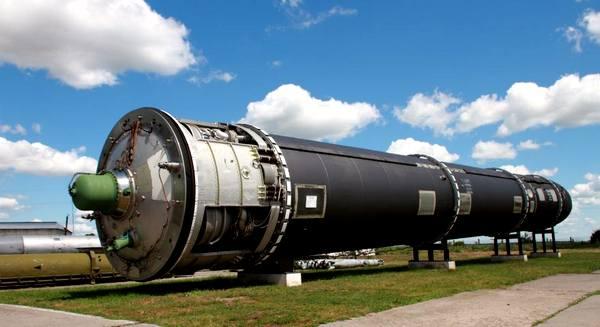
Even though the controls and codes for the launch or operation of the nuclear weapons stationed in Ukraine were inherited by Russia, Ukraine owned weapons in terms of territory, according to the general principle of how the former Soviet armed forces were divided between the new national republics. Ukraine could relatively easily exercise full control over its arsenal by breaking Russian control codes but was warned by the US that such an attempt would lead to the international isolation of Ukraine.
The only real obstacle to Ukraine establishing operational control over its nuclear weapons was the economic hardships of the early 1990s. Ukraine would have had to invest nearly $2 billion at that time to make its nuclear arsenal fully independent and operational. This sum could not be instantly found at the time when inflation peaked at 10,000% per month, and the economy was only at the beginning of establishing new post-Soviet trade routes.
Though most of the personal papers of American leadership about their inner debates on nuclear disarmament remain classified, a memo to the National Security Advisor from March 1992 demonstrated that real disputes took place, and some officials disagreed with the mainstream policy that favored Russia. National Security Council staffer David Gompert, in the memo quoted by Bogned in his research, noted three major counterarguments to the policy of the Clinton administration. The memo was titled "We must be adamant about de-nuclearizing Ukraine" and said:
"Ukrainian nuclear weapons will not threaten the US as Russian nuclear weapons do, for the simple reason that Ukraine, unlike Russia, is not a serious potential adversary. It might even prove advantageous to us to see Russian power checked—and Russian nuclear weapons deterred—by a Ukraine with a minimal deterrent. In any case, we hurt ourselves with the Ukrainians by insisting that they be stripped of nuclear weapons while we legitimize those of their powerful neighbor."
The arguments of the Clinton administration eventually prevailed, and Ukraine was not only forced to disarm but also refused to get genuine security guarantees and assistance from the West, which it desperately attempted to earn in exchange for nuclear disarmament.
Instead, Ukraine gave up its entire nuclear arsenal, receiving in exchange financial aid from the US and energy supplies from Russia at a discounted price. This policy, which generally favored Russia, was not reconsidered in the following years both in NATO and the EU. The allies didn't propose to Ukraine any real timely-bonded perspectives of NATO membership up until the Russian full-scale attack in February 2022, when Ukraine was recognized as a country that will become a member of the alliance without the previously required Membership Action Plan "as soon as the conditions are met."
Read more:
- Unpunished evil grows: Ukraine war rooted in Russia’s impunity for Chechen genocide
- Ukraine’s parliament officially recognized Chechen Republic of Ichkeria occupied by the Russian Federation
- The 1994 secret operation that saved Crimea, and perhaps Ukraine, from Russian occupation
- The Budapest Memorandum: Brother, Can You Spare a Security Assurance?
- Was Ukraine’s nuclear disarmament a blunder?


